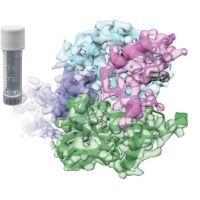Specification
| Description | Recombinant protein from the full-length sequence of Homo sapiens ribosomal protein S6 kinase A1 (RPS6KA1), transcript variant 1 (NM_002953). |
| Organism | Homo sapiens (Human) |
| Expression Host | Human Cells |
| Tag Info | His or DYKDDDDK. Please contact us if you need further information or require specific designed tag. |
| Purity | Greater than 90% by SDS-PAGE gel |
| Uniprot ID | Q15418 |
| Entry Name | KS6A1_HUMAN |
| Gene Names | RPS6KA1 MAPKAPK1A RSK1 |
| Alternative Gene Names | MAPKAPK1A RSK1 |
| Alternative Protein Names | Ribosomal protein S6 kinase alpha-1 (S6K-alpha-1) (EC 2.7.11.1) (90 kDa ribosomal protein S6 kinase 1) (p90-RSK 1) (p90RSK1) (p90S6K) (MAP kinase-activated protein kinase 1a) (MAPK-activated protein kinase 1a) (MAPKAP kinase 1a) (MAPKAPK-1a) (Ribosomal S6 kinase 1) (RSK-1) |
| Application | Antigens, Western, ELISA and other in vitro binding or in vivo functional assays, and protein-protein interaction studies; For research & development use only! |
| Buffer | Purified protein formulated in a sterile solution of PBS buffer, pH7.2, without any preservatives |
| Endotoxin | Endotoxin level is < 0.1 ng/µg of protein (<1EU /µg) |
| Length | 735 |
| Molecular Weight(Da) | 82723 |
| Protein Sequence | (The sequence of expressed protein may have some variation from the sequence shown below. Please contact us for the exact sequence.) MPLAQLKEPWPLMELVPLDPENGQTSGEEAGLQPSKDEGVLKEISITHHVKAGSEKADPSHFELLKVLGQGSFGKVFLVRKVTRPDSGHLYAMKVLKKATLKVRDRVRTKMERDILADVNHPFVVKLHYAFQTEGKLYLILDFLRGGDLFTRLSKEVMFTEEDVKFYLAELALGLDHLHSLGIIYRDLKPENILLDEEGHIKLTDFGLSKEAIDHEKKAYSFCGTVEYMAPEVVNRQGHSHSADWWSYGVLMFEMLTGSLPFQGKDRKETMTLILKAKLGMPQFLSTEAQSLLRALFKRNPANRLGSGPDGAEEIKRHVFYSTIDWNKLYRREIKPPFKPAVAQPDDTFYFDTEFTSRTPKDSPGIPPSAGAHQLFRGFSFVATGLMEDDGKPRAPQAPLHSVVQQLHGKNLVFSDGYVVKETIGVGSYSECKRCVHKATNMEYAVKVIDKSKRDPSEEIEILLRYGQHPNIITLKDVYDDGKHVYLVTELMRGGELLDKILRQKFFSEREASFVLHTIGKTVEYLHSQGVVHRDLKPSNILYVDESGNPECLRICDFGFAKQLRAENGLLMTPCYTANFVAPEVLKRQGYDEGCDIWSLGILLYTMLAGYTPFANGPSDTPEEILTRIGSGKFTLSGGNWNTVSETAKDLVSKMLHVDPHQRLTAKQVLQHPWVTQKDKLPQSQLSHQDLQLVKGAMAATYSALNSSKPTPQLKPIESSILAQRRVRKLPSTTL |
Background
| Function | FUNCTION: Serine/threonine-protein kinase that acts downstream of ERK (MAPK1/ERK2 and MAPK3/ERK1) signaling and mediates mitogenic and stress-induced activation of the transcription factors CREB1, ETV1/ER81 and NR4A1/NUR77, regulates translation through RPS6 and EIF4B phosphorylation, and mediates cellular proliferation, survival, and differentiation by modulating mTOR signaling and repressing pro-apoptotic function of BAD and DAPK1. In fibroblast, is required for EGF-stimulated phosphorylation of CREB1, which results in the subsequent transcriptional activation of several immediate-early genes. In response to mitogenic stimulation (EGF and PMA), phosphorylates and activates NR4A1/NUR77 and ETV1/ER81 transcription factors and the cofactor CREBBP. Upon insulin-derived signal, acts indirectly on the transcription regulation of several genes by phosphorylating GSK3B at 'Ser-9' and inhibiting its activity. Phosphorylates RPS6 in response to serum or EGF via an mTOR-independent mechanism and promotes translation initiation by facilitating assembly of the pre-initiation complex. In response to insulin, phosphorylates EIF4B, enhancing EIF4B affinity for the EIF3 complex and stimulating cap-dependent translation. Is involved in the mTOR nutrient-sensing pathway by directly phosphorylating TSC2 at 'Ser-1798', which potently inhibits TSC2 ability to suppress mTOR signaling, and mediates phosphorylation of RPTOR, which regulates mTORC1 activity and may promote rapamycin-sensitive signaling independently of the PI3K/AKT pathway. Mediates cell survival by phosphorylating the pro-apoptotic proteins BAD and DAPK1 and suppressing their pro-apoptotic function. Promotes the survival of hepatic stellate cells by phosphorylating CEBPB in response to the hepatotoxin carbon tetrachloride (CCl4). Mediates induction of hepatocyte prolifration by TGFA through phosphorylation of CEBPB (By similarity). Is involved in cell cycle regulation by phosphorylating the CDK inhibitor CDKN1B, which promotes CDKN1B association with 14-3-3 proteins and prevents its translocation to the nucleus and inhibition of G1 progression. Phosphorylates EPHA2 at 'Ser-897', the RPS6KA-EPHA2 signaling pathway controls cell migration (PubMed:26158630). {ECO:0000250|UniProtKB:P18653, ECO:0000250|UniProtKB:Q63531, ECO:0000269|PubMed:10679322, ECO:0000269|PubMed:11684016, ECO:0000269|PubMed:12213813, ECO:0000269|PubMed:15117958, ECO:0000269|PubMed:15342917, ECO:0000269|PubMed:16213824, ECO:0000269|PubMed:16223362, ECO:0000269|PubMed:16763566, ECO:0000269|PubMed:17360704, ECO:0000269|PubMed:18722121, ECO:0000269|PubMed:26158630, ECO:0000269|PubMed:9430688}. |
| Pathway | |
| Protein Families | Protein kinase superfamily, AGC Ser/Thr protein kinase family, S6 kinase subfamily |
| Tissue Specificity |
QC Data
| Note | Please contact us for QC Data |
| Product Image (Reference Only) |  |

